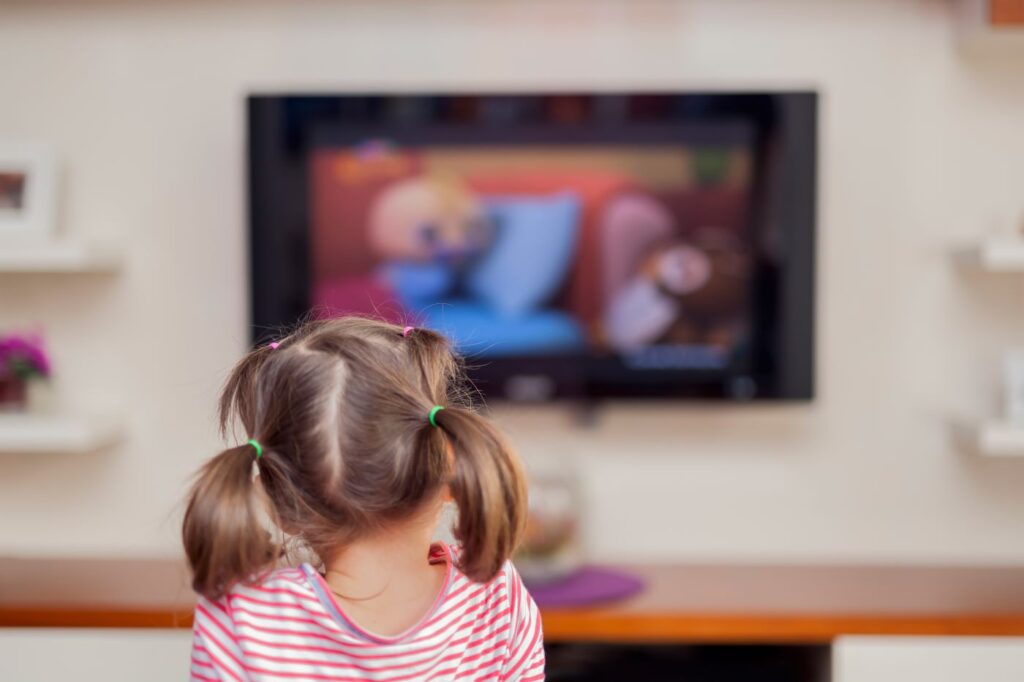My eldest daughter never saw a video or any other screen for the first two years of her life. Not once.
I was, you see, a Perfect Parent.
All this changed just after her second birthday when we found out that I was expecting our second child. Between caring for a two-year-old and battling morning sickness, this was simply not the time to limit television.
Maybe a true Perfect Parent would have found some way around this, could have somehow magicked up the family support and babysitting and income and good health and regular date nights that might have meant that children’s television was never used in our family. But, like many other wonderfully imperfect parents, this was not the case for me. In the context of the “survival mode” that is so typical of the little years, limited amounts of screen time can be used prudently and in good judgment to serve the overall good of the family.
Start your day with Public Discourse
Sign up and get our daily essays sent straight to your inbox.My husband and I went on to have two more children after that second baby, and along with the kids and the jobs and the minor crises and life in general came several more seasons of moderate reliance on “Little Bear,” “Paw Patrol,” and “Rescue Bots Academy” as we navigated our many blessings and responsibilities.
Of course, in terms of family use of technology, the occasional deployment of “Paw Patrol” is one thing; a seven-year-old who spends hours each day unsupervised on an internet-enabled tablet is another. What about that? Is that okay? What ought we consider when determining whether we should let our children enjoy screens—and how much? What about smartphones, TikTok, virtual reality, and the numerous (and ever-proliferating) other types of technology that beckon to us?
Parental Modeling and the Double-Edged Sword of Technology in the Home
Managing technology in a family context is a serious challenge. Digital technologies, in the ways and at the rates that young people are using them today, are having demonstrably negative, even devastating effects on young people’s brains, bodies, spirits, and socialization. Such findings are deeply distressing.
Yet by and large, we do not know quite what to do about this. It seems an impossible problem. How can we shield our kids from a zeitgeist that is so pervasive?
There is no shortage of opinions on how to manage the ubiquity of tech, and some are very good. Should we delay our children’s access to smartphones, for example, as Jonathan Haidt suggests? Should we follow in the footsteps of Sweden and try to remove most tech from schools?
Every parent will have his or her own opinion on these matters. But there is one key, frankly very uncomfortable, factor without which even the best of such ideas are sure to fail our kids: that at least in part, responsible technology use is caught, not taught. The modeling parents offer matters a great deal. And we do not always model well.
At least in part, responsible technology use is caught, not taught. The modeling parents offer matters a great deal. And we do not always model well.
In discerning how to best model prudent technology use, one potential solution is to throw everything with a screen or an internet connection out the window (and good riddance). Unfortunately, this is almost always unrealistic. Yes, we may be able to keep technology away from our children, more or less, for as long as they are not exposed to it elsewhere. But most parents who work for wages must use digital technologies in their work, whether as a tool or for communication. This means that even those adults who find effective ways to place limits on their technology use will still utilize devices in ways related to their work. Even if the adult in question is, for example, a full-time homemaker, there will still be the need to use technology to communicate with friends and access information related to the work of the home.
As many parents have transitioned to remote work over the past few years, we also find ourselves unable to create hard-and-fast distinctions between professional work and parenting. We may be feeding the kids lunch while in the middle of a work call, for example. This has its benefits—more flexibility and more hours spent with our children—but it also makes it harder than ever to turn off our attention to technology when we are at home.
So if just throwing out our tech is impractical, what might we do instead?
The Three Rs of “Unmachining”
Recently, authors Ruth and Peco Gaskovski addressed a related question in a Substack essay introducing the “3 Rs” of what they call “unmachining:” moving from being controlled by tech to controlling tech yourself and living primarily in the physical, not the virtual world. These three Rs—Recognize, Remove, and Return—point out that it is not enough simply to know that smartphone addiction, for example, harms us (that’s the “Recognize” part). No, we also need to find practical yet realistic ways to remove or restrict those technologies that are not net gains for us overall. Finally, we also need to re-engage in (Return to) community and individual ways and experiences that are connective, grounding, and humane.
In other words, if we want to change anything about tech in our lives, we need a strategic, realistic, well-designed plan. Not all of us will want to go as far as the Gaskovskis, who chose to eschew all television for their young children, for example, and to delay their children’s cellphone use until the late teens. You may wish to do this, or you may just wish to grow in intentionality and discernment with tech, rather than to move significantly away from a technological lifestyle. But even in this case, a real plan is going to be necessary. The question is: what would you like to change about tech in your family life? What would you like to model differently than you do now, and what would you like to teach your children about the digital world?
Add before You Subtract: An Unlikely Parallel in Diet Culture
Whatever your goals, the truth is that finding ways to model good tech use and to introduce your children to tech responsibly (including restricting them from it as necessary) will likely be an extensive, countercultural, challenging project.
But it may not be as hard as it sounds. As encouragement, I’d like to suggest a principle that I learned from an unlikely source: nutritionist Becky Gillaspy. She encapsulates a prudential, healthy concept of moderation in four words: add before you subtract.
When you need to change a habit like poor eating or overreliance on tech, willpower alone is usually insufficient to make a long-term change. The reason is that while these sorts of habits and coping mechanisms may do us harm in some areas, they actually meet some of our very real needs. They serve us; that’s why we use them. So if we remove them without first replacing them, we suffer immensely and often relapse into our bad habits as a result.
For example, imagine that I have the habit of eating two donuts for breakfast every morning. This is probably bad for my physical health. Conventional dieting advice would instruct me to, well, just stop. To replace the donuts with half a grapefruit. Taking this advice would leave me both physically and probably emotionally hungry. It fails to consider the emotional void that donut-eating fills: perhaps I’m lonely, and my daily talk with the donut shop employee brings much-needed social connection. Maybe eating the donut itself floods me with dopamine and distracts me from my suffering. Maybe donuts remind me of Saturday morning outings with my dad when I was a little girl.
Therefore, any dietary changes need to be accompanied by a plan to meet my needs for social contact, emotional stability, and meaning before yanking the current source. Can I switch to buying coffee instead of donuts at the shop each morning? Maybe call my dad more often, too?
This same principle applies to technology. It, too, meets a variety of social, emotional, and practical needs. For instance, consider the full-time homemaker with three young children who is starved for connection with other adults. For her, the smartphone and texting are a portal to adult connection while her pre-rational children are dumping out their bowls of oatmeal. Social media offers a sense of companionship during late-night nursing sessions. But the tech is not really enough; it may take the edge off of some of our neediness, but it won’t solve the underlying problem. At some point, we must ask: in this attempt to fill very real, very important needs, are we settling for something insufficient? And, if so, what might we add to better fill those real needs before removing any and all useful tech from our homes?
At some point, we must ask: in an attempt to fill very real, very important needs, are we settling for something insufficient? And, if so, what might we add to better fill those real needs before removing any and all useful tech from our homes?
Virtue in the Mean: A Personal Example
In my own journey to adopt a healthy use of tech, I realized I needed to take a hard look at my expectations for myself and finally accept my neighbor’s offer to watch the kids while I got coffee with a friend. I have begun replacing my texting with actual phone calls (or e-mails—using tech better, rather than never) to connect myself more deeply with people I know. At night, I might try reading a book instead of scrolling my phone while I nurse my baby.
In other words, I’ve realized that there is some middle ground in our family lives between pretending we can do without tech entirely and simply throwing up our hands and giving in to its harms. Practically, there are many approaches to take; but taking into account the needs that tech partially meets for us seems to be an essential part of finding success in building a healthy relationship with its use in our homes.
In my home, that two-year-old I mentioned is now almost a teenager, and she and our second-born have only just recently begun using a computer. The main reason for this new activity is that it is no longer practical for me to type all of their stories and essays for them. Typing is an important skill for them to learn, and they are interested in learning it. So every day, more or less, they each spend about fifteen minutes using an interactive online typing program. They’re having an absolute blast with it. (And they still have to practice their cursive by hand!)
In a year or two, we’ll probably introduce our eldest to well-monitored internet research, too; and we do have a dumbphone that we send with the older kids when they go on an errand. So we do make careful use of tech when it makes sense to us in our family context (which, to be honest, is not often).
When we do find that we need to cut back on our children’s already limited tech use, it is just as important to add before we subtract for them as it is for adults. For example, after a week of illness and thus hours on end of movies and TV shows each day, it’s not enough to just pull the plug. Instead, we have to invest in going outside with the kids, drawing them into our chores (like cooking), and getting back to filling their emotional tanks so that they can run off happily to play without the crutch of tech support. We also have worked hard to create a home atmosphere that emphasizes outdoor play, artwork, and music so that there are plenty of opportunities for the kids instead of watching yet another movie. I have never once regretted purchasing the second-hand piano or the giant pile of eight-foot pine beams that we keep in the backyard for the children’s use in building forts. Routines help, too; when we are in a good season, for example, the kids know that we generally don’t watch movies or shows on school days. Because this is routine, they are freed from constantly wondering whether we might let them watch something.
Just as importantly, as a work-from-home parent, I have found that my tech use can be draining to the kids, who have to be patient with me while I’m doing work on the computer at home during the day. So I have had to establish no-tech times for myself throughout the day—no multitasking on my laptop while homeschooling, for example—and commit to completely unplugging on the weekends. The kids need some times when I give them undivided attention, and some times when they must respect my need to attend to my work. Taking a total tech break for two days straight on the weekend can be challenging, but it is worth it for the way that it allows me to spend rich, fully focused time with my husband and children.
But as for the overwhelming digital world generally, well, introducing our children to the great array of digital technologies will be an adolescence-long project with each of them, or so we anticipate. We hope to guide them via conversation and example in the use of a phone, or tablet, or whatever is the device du jour when they are sixteen or so and still living in our home. We would like to empower them to make good decisions about tech use instead of allowing the tech to lead the way.
Still, I am very glad my husband and I have been able to protect our children, by and large, from the mental, emotional, physical, and social influences of the digital world so far. The gift of a childhood spent in books and LEGOs and the nearby coffee shop, and the good, old-fashioned grass and dirt, is something that I hope will give them the strength to evaluate technology wisely as adults. And we will try to equip them, too, should they ever have trouble, to add before they subtract.
Image by Myst and licensed via Adobe Stock. Image resized.














